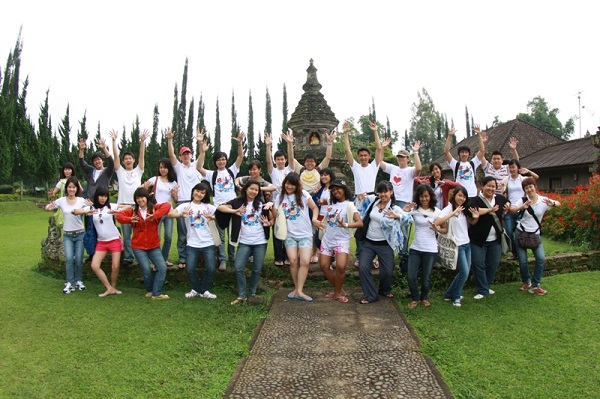By Angela Astri Soemantri (Choral Conductor),
Michael Mulyadi (Music Journalist) and
Monty P. Satiadarma (Psychologist)
Indonesian Folk Choral Music
Over the past ten to fifteen years, various Indonesian choirs have racked up many achievements at international choir festivals, primarily in the folklore category. Undoubtedly the richness and diversity of Indonesian culture have influenced the choirs’ performances and impressed judges and public spectators with their blend of vocals and stage acts that include costumes. Indonesia’s geography plays an important role in its cultural diversity, influencing more than two hundred million people, living in more than thirteen thousand islands of this equatorial archipelago in South East Asia. From the rhythmic rattling sound of the lush hills to the roar of the giant Indian Ocean waves, nature’s sounds are carried along with traditional customs and spiritual beliefs, creating the nuances displayed by every Indonesian choir. Singing has been a traditional custom in this nation, reflecting both the colors of nature and the diversity of cultures. Indonesians sing lullabies to their babies nestled in hammocks; they sing to their land and soil when planting and harvesting rice; and they glorify the universe to give thanks to the Creator.
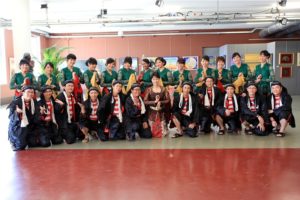
Indonesia is a festive land where the people celebrate life by singing and dancing at festivals and when receiving guests in villages. Group singing is part of the custom: Choirs have traditionally existed in Indonesia, although they may sing in unison. Music and rhythm are part and parcel of activities as diverse as tea planting and harvesting; fishing and grinding rice; praying in a mountain-top temple, and child’s play in the small yard of a hut.
The singing tradition in Indonesia goes back decades, perhaps even centuries. Spiritual chants date back possibly to the period of the Hindus, or even to a few hundred years B.C. Although no musical notation has been found, we do have simple words written as lyrics on stone tablets and bamboo, which historians assume were chanted or sung glorifications of the gods, the universe or the king. Such concepts are similar to those found in Babylonian, Egyptian and Hellenic cultures thousands of years before Christ.
Indeed, our Western Indonesian ancestors who came from Yunnan Province in Southeast Asia carried musical knowledge along with their agricultural practices. Indonesians still include music in their agricultural celebrations, as do the people of Myanmar and Cambodia. Our Eastern Indonesian ancestors, who were related to the Aborigines of the southern hemisphere, also tend to be festive during fishing and hunting.
Christianity expanded in several regions of Indonesia during the 17th through the 20th centuries, thanks to the influence of Dutch and Portuguese government agents and traders with the East Indies. In Northern Sumatra, North Sulawesi (Celebes), Central Java, the Mollucas, New Guinea and the Lesser Sunda Islands, Protestant and Catholic beliefs were both widely accepted by the local population. Local traditional music was assimilated into the new church music introduced in the course of evangelization. Collective singing slowly took on the new form of choral singing, and local worship tunes adopted Western harmonies. Churches started to exert an important role in shaping the art of choral singing. Hymns were written and community choirs established to serve local congregations. In recognition of the pleasant impact such activities had on their spiritual life, parishioners wrote Masses and made recordings. Over the years these new vocal compositions created a more pleasant spiritual atmosphere during services.
Along the way, western musical knowledge and methods were passed from missionaries to locals, who learned the harmonious do re mi system, which differed from the traditional pentatonic music. All these factors contributed to the development of distinct musical expressions in each region, a mixture of both local collective singing and western choral traditions.
Meanwhile, Western military hymns and marches imported to Indonesia during the Dutch era influenced many Indonesian musicians and composers, leading them to create Indonesian epic songs based on what they had learned about composition in Dutch-Indonesian schools. For example, the Indonesian national anthem and various hymns were composed during World War II by national composers who had previously worked for the national radio station that broadcast classical music.
However, it is not possible for choirs to sing only the national epic songs, but no other secular choral repertoire existed! Most choirs are not church-based and have no affiliation with any religious organizations, and may limit their use of sacred choral music, including polyphonic music, because it may contradict some peoples’ religious beliefs. Access to the secular musical canon was also very limited until the end of the 1980s. Musical scores and choral books were rare and hard to find even in bookstores in the capital city of Jakarta, as they all had to be imported. Indonesia itself only had a handful of choral experts at the time, making it more challenging still to explore the standard Western repertoire. As a result, many local choir activists turned to their local music heritage: Composers and arrangers began to look at traditional Indonesian songs as the basis for new choral compositions. Countless themes have already been captured in numerous folksongs, which have become an incredibly rich source of inspiration. Even a single theme may be cultivated in several dialects and melodies, such as Indonesians’ well-known lullaby melodies — “Nina Bobo”, “Lelo Ledung” and “Soleram”, to name a few.
In this multi-ethnic nation, influential traditional cultures have blended together and re-formed a number of musical compositions, either by retaining their basic tune, being re-composed into a modern tune, or turning into a uniquely integrated style. Traditional dance and spiritual aspects have been recreated as part of vocal compositions, making for spectacular choral performances. The growth of such concepts has invited and motivated young composers to create dynamic musical innovations that reflect Indonesian culture.
Indonesian choral arrangers are numerous: Agustinus Bambang Yusana is known for his work as a conductor and choral arranger of Indonesian folk songs. Based on personal experience and study, he composes works of high sensitivity with strong Indonesian ethnic nuances. Yusana believes that the richness of Indonesian culture, plus the uniqueness of its music, can deliver peace into a listener’s heart and mind, as well as harmonious sounds. Through his choral arrangements, he tries to expresses his creativity while enriching the diversity of Indonesian music in choral performance.
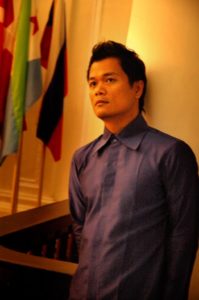
The Yamko Rambe, a song from West Papua, was his first composition; it exposed his strength in composing Indonesian choral music. He starts the process by collecting background information on the ethnicity and origins of a song in order to really tune in to the characteristics of the music, to the traditions and rituals surrounding the song, and to know how the sound is reflected in the habits of that ethnic group. This essential fundamental ethnic and cultural knowledge leads him to find spots where he can improvise around the melody. For instance, the shouts the Papua people use to call out to each other were inserted into a song in the form of yells, not only to give beauty to the song or as a decorative ornament, but to give meaning to the interpretation of the melody. Yusana’s compositions always add to the development of contemporary music: his adjustments may relate to the interpretation of the lyrics, may add musical instruments such as percussion, or include rhythmic dance. So long as the original core of the song is maintained, such improvisations don’t seem to damage the song; rather, they beautify the song’s overall performance.
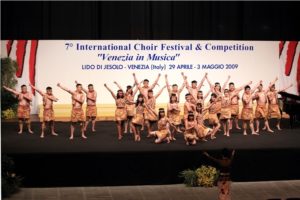
Together with a good sense of musicality, the multiethnic dimension creates unique musical compositions. Thus, Indonesian folklore compositions tend to spur choirs to reveal the uniqueness of the music of Indonesia’s ethnic groups.
Any discussion of Indonesian choral folk music will necessarily be a long one, as the richness of Indonesian culture is an endless topic for discussion, exploration and analysis. Indonesian music is continually being developed as part of the world’s heritage. Anyone interested in choral music can feel the vast Indonesian multi-ethnic and multi-cultural dimensions by exploring it.
Choral Education in Indonesia
Singing is part of regular social activities in Indonesia, including schools. In almost every elementary school, singing is included in the curriculum. At least once a week, students attend voice classes. They learn to sing together and to sing one by one in front of the classroom, receiving grades from the teacher. Schools provide these classes to enable students to sing the national anthem, national patriotic songs (marches and hymns) and Indonesian children’s songs. Students and teachers normally get together to raise the flag and sing the national anthem on national holidays, including the annual independence day (August 17). Some schools also do so on National Education Day in May and on the “Pancasila Day” in October (where the country’s five founding principles are celebrated), as well as on other patriotic holidays. Almost every student in the country must memorize the national anthem and several other patriotic songs. (During university new-student orientations, upper classmen often ask freshmen to sing the national anthem: If they have forgotten it, they may be bullied.)
The development of Christian choirs motivated schools, universities and other communities within Indonesian society to develop their own choral activities, each influenced by their particular ethnic, social and religious backgrounds. As a result, choral activity is booming. For example: During the World War II era, choir concerts were broadcast on national radio to motivate soldiers; during the 1970s, wives of military personnel developed choral activities to perform in public; university students also participate in choirs as an extracurricular activity.
Choral festivals also began to flourish, supported by the Department of Culture and Education (for students) and the Social Department. The impact was rather unexpected: Since the mid-1970s, when choral activities bloomed in various provinces – in the form of amateur festivals, professional festivals, student festivals, ethnic and cultural festivals, or national holiday celebrations – we have rarely seen any government-sponsored festival without a choir.
Although singing or voice lessons are included in the school curriculum, and group or communal singing represents part of a student’s educational duties, there is no official strictly choral education in Indonesia. Students may participate in a choral group as an extracurricular activity or join a neighborhood or church choir. Over the past two decades, national and provincial authorities have developed choral festivals, some with government financial support, but have not introduced choral education. Voice class remains as the official curriculum, mostly in non-choral form. Voice class teachers are not required to have any background in vocal education, so long as they can play an instrument. A few schools may impose that requirement, but most do not. Activities that are supposed to help students explore various musical aspects of the human voice turn out to be only general music concepts, based on whatever limited personal knowledge the teacher may possess. Indicators of success, namely, good grades, may depend only on the student’s ability to sing a song in SA, SSA, SAB or SATB format, but not on the student’s skill actually performing singing techniques. Very often teachers choose an inappropriate repertoire; thus students are unable to perform it well. This may be due to the teachers’ limited skill in choosing and finding appropriate music, or to their inability to determine which repertoire is most in accord with their students’ skills, or even to a lack of knowledge about the concept of choir itself.
Educational programs in Indonesia do not pay as much attention to musical talent and skill development as they do to mathematics and linguistics. Even in linguistics, programs pay more attention to grammar constructions than to literature. Ironically, Indonesian society is rather poetic in its linguistic expression. Poems, lyrics and chants remain part of the gathering tradition of many Indonesian tribes and ethnic groups. Expectations that students will be provided opportunities to develop their artistic talents at school remain bleak for several years to come, although opportunities to do so in the community are promising: While schools provide no choral lessons for various reasons, the number of private community-based music institutions is growing, particularly in big cities such as provincial capitals.
The passion for choral music has increased in Indonesia as it has throughout the world. Indonesians who have had the opportunity to go abroad and study choral music have returned bringing enlightenment for the development of Indonesian choral music. These scholars have brought new approaches to the study of choral music from all over the world, inspiring many Indonesian choral music activists who have been hungering for new knowledge. Regrettably, the process of knowledge transfer tends to occur in private music institutions rather than in public schools. While public school choirs are limited by the teachers’ lack of choral music education, private music school students tend to make better progress, thanks to instructors with international educational backgrounds and more experience leading choirs.
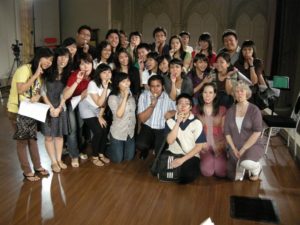
We may consider these private music institution teachers as pioneers of Indonesian choral music. Many have been members of university or church choirs, or have pursued Master’s degrees in music abroad. Two decades ago, choral activities in Indonesian universities were considerably more scarce than they are today: Only a few had student choirs, and the forms were considerably simpler as well. They tended to sing hymns and anthems in monophonic style, and directors rarely arranged songs into complex compositions as they do now. Church choirs have sung more complex vocal compositions for a long time, but tended to perform only during church services. Thus communities had only a limited awareness of that style of music.
Slowly but surely choral music in Indonesia has begun to show substantial progress. Many choir concerts are held in schools, concert halls and churches, and are sought after and enjoyed by locals and foreigners. Audiences are being invited not only to enjoy the performance but also to learn about the repertoire being presented. Inspiration and creativity may emerge from such performances, and high-quality choirs that perform advanced musical compositions motivate other choirs to develop their own skills as a result of the experience of attending such concerts.
Concerts in Indonesia no longer aim merely to provide a theatrical performance but also to continually improve in quality and to explore a more creative repertoire. Although the number of children’s choirs is still limited, recent concerts indicate that they have learned good basic singing skills, no doubt taught by experienced and knowledgeable teachers.
It does not stop there: Motivated choir lovers have supported the development of choir activities by inviting international experts to conduct master classes, primarily in urban areas of Indonesia. Many choirs participate actively in such programs.

The multicultural country that is Indonesia currently holds huge potential to have an impact on music, in particular on choirs. Indonesia has significant human resources, but limited expertise in music education and the lack of attention from the government may cause an uneven development of choral music in Indonesia, resulting in developmental gaps between geographic areas.
Indeed, Indonesian music lovers, primarily lovers of choral music, have high hopes that our choirs will develop significantly in the near future. Of course, those active in choirs must work hand in hand with all of society in promoting music to the larger population. Numerous sub-groups and geographical areas within the country are not familiar with choir performance. They may not be aware of how much a group of people can develop singing together into a choir with high quality standards. Many social sectors need to work together to promote and develop Indonesian choirs, beginning with the schools: Choir activities need to be included in the national educational program. However, music education must extend to the educators themselves – they must have the appropriate educational background to conduct such a program for children. Finally, of course, the government needs to support the development of music education for music educators by providing financial resources in the future.
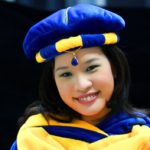 Angela Astri Soemantri is a candidate for the Master of Educational Psychology degree. She has dedicated 14 years of her life to teaching music, primarily piano. For the last 10 years, she has focused on the study of choral music, becoming actively involved in solo and ensemble workshops and master classes. She is passionate about passing that knowledge along to her choristers: She conducted the Monarch Orcaellanum Luminare (MOL) Choir (previously known as Orcaellae Vox Sacra) in an international choir competition in Venice, Italy (May, 2009), where she won two gold diplomas (in the Mixed Chamber and Folklore categories). Proud to be an Indonesian, Ms. Soemantri is committed to bringing the richness of Indonesian culture to the entire world through choral music. Email: angela.astri@gmail.com
Angela Astri Soemantri is a candidate for the Master of Educational Psychology degree. She has dedicated 14 years of her life to teaching music, primarily piano. For the last 10 years, she has focused on the study of choral music, becoming actively involved in solo and ensemble workshops and master classes. She is passionate about passing that knowledge along to her choristers: She conducted the Monarch Orcaellanum Luminare (MOL) Choir (previously known as Orcaellae Vox Sacra) in an international choir competition in Venice, Italy (May, 2009), where she won two gold diplomas (in the Mixed Chamber and Folklore categories). Proud to be an Indonesian, Ms. Soemantri is committed to bringing the richness of Indonesian culture to the entire world through choral music. Email: angela.astri@gmail.com
 Monty P. Satiadarma is a registered psychologist, a member of the [Indonesian] National Board of Psychologists, and an affiliate of various international psychological associations. He is a psychotherapist, art therapist, family therapist, researcher, and the former Dean of Psychology and President of a private university. He has also published books on music therapy. Email: monty_satiadarma@yahoo.com
Monty P. Satiadarma is a registered psychologist, a member of the [Indonesian] National Board of Psychologists, and an affiliate of various international psychological associations. He is a psychotherapist, art therapist, family therapist, researcher, and the former Dean of Psychology and President of a private university. He has also published books on music therapy. Email: monty_satiadarma@yahoo.com
 Michael Mulyadi has studied piano, voice and conducting. He is an active classical music journalist and is sought for his opinions on classical music in Indonesia Since 2003, he has also been a choral conductor, focusing on church music; he is currently principal conductor of the Eliata Choir. Email: michael_budiman@yahoo.com
Michael Mulyadi has studied piano, voice and conducting. He is an active classical music journalist and is sought for his opinions on classical music in Indonesia Since 2003, he has also been a choral conductor, focusing on church music; he is currently principal conductor of the Eliata Choir. Email: michael_budiman@yahoo.com
Edited by Anita Shaperd, USA

